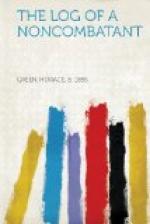Though not officially admitted to the besieged city, I went at once to my old stand, the Hotel St. Antoine, now converted into British Staff Headquarters. At sundown a mist crept up from the river, and through it we heard a roar of welcome and the rumble of heavy artillery. Charging down the Avenue de Keyser came a hundred London motor-busses, Piccadilly signs and all, some filled, some half-filled, with a wet-looking bunch of Tommies, followed by armored mitrailleuses, a few 6.7 naval guns, officers’ machines, commissary and ammunition carriages—the first brigade of Winston Churchill’s army of relief, which for five days was destined to make so valiant, but so short, a fight against the overwhelming German army.
Chapter V
The Bombardment Of Antwerp
There was something typically British in the way those Englishmen went about the defense of Antwerp. In the streets and barracks, and more especially at the Hotel St. Antoine, British Staff Headquarters, where I stayed until its doors were closed, I saw them at close range during that week of horror. Once when I was eating with a company of marines near their temporary barracks, they gave me the password to the trenches, and, although I only got out as far as the inner line of forts on that day, it gave me an opportunity to observe the work of the men under long-range firing. At the St. Antoine, ten or a dozen officers were quartered; others clanked in and out for hurried conferences in the corridors or disappeared into the smoking-room, whose heavy doors with the sign, “Reservee pour la Gouvernement Anglaise,” hid Winston Churchill, then First Lord of the English Admiralty, and his portmanteau of war maps.
Here was Belgium’s last stronghold on the verge of downfall: the outer line of forts had already fallen; Forts Wavre, St. Catherine, Waelham, and Lierre were already prey to the Krupp mortars; the German hosts were swarming across the River Nethe, six miles to the city’s south, and the cowering populace in their flight made the streets terrible to look upon.
Yet at the St. Antoine there was no particular flurry—so far, at least, as the officers were concerned. At night they worked over their war maps; in the daytime they went out to the forts. They would get up in the morning, an hour or two earlier than the average business man, have a comfortable breakfast, smoke a cigar for half an hour or so, and talk things over. Then their military automobiles came trembling and sputtering to the doorsteps, and in groups of fours and fives they went out to the firing line. If only two or three of a group returned, you would naturally have to draw your own conclusions as to the fate of the rest.
Those English gentlemen went about their jobs of life and death with the same detached coolness as if their hunters were being saddled, or they were waiting for the referee’s whistle in Rugby football. Their attitude was infernally exasperating; yet you couldn’t help taking off your hat to their sublime nerve and indifference.




